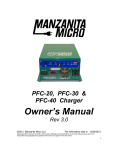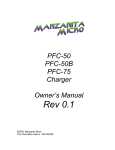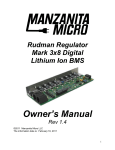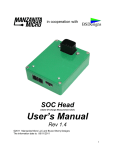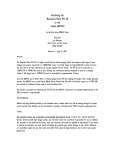Download to view the PFC Charger User Manual
Transcript
PFC-20, PFC-30 & PFC-40 Charger Owner’s Manual Rev 2.4 ©2012 Manzanita Micro LLC The information date is: 2/3/2012 1 CONTENTS IMPORTANT SAFETY WARNINGS……………..………………………… 3 IMPORTANT BATTERY SAFETY INFORMATION……………………… 4 GENERAL OVERVIEW………………………………………………………5 KEY FEATURES LIST………………………………………………………. 6 DIMENSIONS AND SPECIFICATIONS…………………………………… 7 CHARGER OPERATION…………………………………………………….8 - Photo of Charger Face With Callouts…………………………………. 8 - Volts Trim ~ Adjusting the Peak Charging Voltage Limit………….. 9-10 - Reg Bus ~ Basic Info……........………………………………………….. 11 - Descriptions of Panel LED Indicators…….……………………...…….11-12 - Dip Switches……………………………………………………………….. 13 WIRING YOUR MANZANITA MICRO CHARGER……………………….. 14 - Connecting the Charger to the Battery Pack………………………… 14 - Connecting the Charger to the Wall…………………………………… 15 - PFC20 Wiring………………………………………………………………. 16 - PFC30 Wiring………………………………………………………………. 16 - PFC40 Wiring………………………………………………………………. 16-17 - Running Your PFC Charger on DC instead of AC…………………... 17 - 120V Standard Adapter Drawing for PFC20 & PFC30……………….18 - 120V Standard Adapter Drawing for PFC40………………………….. 19 - Reg Bus Wiring & Pin-out Info………………………………………….. 20 - Reg Bus Cable Construction..…………………………………………...21-23 - New 8A Control Board Additional Features…………………………...24 - AC Line Power Meter Options………………………………….………...25 CONTACTING MANZANITA MICRO....................……………………….. 26 2 READ THIS FIRST! ADDITIONAL NOTES AND PRODUCT MANUALS AVAILABLE AT: www.manzanitamicro.com CAUTION: Your PFC-Charger uses High Voltage DC and AC electricity. The chargers have been designed to be adaptable for use with many different battery types and voltages. It is the responsibility of the end user to properly set up the charger making necessary adjustments so that it can work with their unique system. With such flexibility, the charger is intended to be able to be configured for use in various experimental applications and Manzanita Micro LLC and its employees, contractors and affiliates cannot be responsible for any damages due to any Manzanita Micro product that has been set up by the end user. There are too many variables out of Manzanita Micro's control. It is entirely the responsibility of the end user to make sure that they are competent to work with potentially lethal voltages and that they have a solid understanding of how to safely integrate the Manzanita Micro product(s) into their application. The information contained in this warning and in the product manuals is intended to be used as a guide to better familiarize oneself with the product(s) but Manzanita Micro has no control over how the information will be used or not used and cannot possibly foresee all possible configurations that a user may come up with. 1. 2. 3. 4. 5. 6. 7. 8. 9. 10. 11. 12. 13. Do not work on the PFC-Charger or attempt to use one if you are not qualified Observe the owner’s manual procedures and cautions Avoid working on an electric vehicle while it’s charging ALWAYS assume that high voltage is present Use electrical tape or another suitable insulator to cover all exposed high voltage connection points and also cover metal tools to reduce the likelihood of the tool completing a current path DO NOT USE A CONDUCTIVE METAL SCREW DRIVER TO ADJUST THE VOLTS TRIM ON YOUR CHARGER! When using a Manzanita Micro BMS with older charger models the Regbus GND return line is NOT ISOLATED FROM MAIN BATTERY PACK NEGATIVE! Never touch or create a path from the regbus conductors to any battery in the pack or serious shock could occur! Disconnect all other non-isolated chargers from the battery pack and from line current Make sure there is NO PATH TO GROUND or the vehicle chassis from any portion of the main battery pack. Make sure the polarity is correct BEFORE you hook the battery pack to the charger cable. Make sure the area around and above the workplace is clean and dry Do not compress or set heavy objects on the charger. Deforming the case can result in shorting the internal circuit boards to the case. DO NOT operate this charger unloaded! A battery pack must always be plugged in to the DC output plug from the charger if it is turned on! FAILURE TO HEED THESE WARNINGS AS WELL AS THE BATTERY WARNINGS ON THE BACK OF THIS SHEET MAY RESULT IN PHYSICAL INJURY, DEATH, OR DAMAGE TO YOUR CHARGER, BMS OR OTHER EQUIPMENT WHICH WILL NOT BE COVERED UNDER YOUR WARRANTY. IT IS RISKY TO PLUG ANY BATTERY CHARGER INCLUDING MANZANITA MICRO CHARGERS INTO GENERATORS. MANY GENERATORS ESPECIALLY THE LESS EXPENSIVE GENSETS DO NOT HAVE A CLEAN, WELL REGULATED, PREDICTABLE OUTPUT AND THEY CAN CREATE HIGH VOLTAGE SPIKES WHICH CAN DAMAGE COMPONENTS IN THE CHARGER. SOME CUSTOMERS HAVE HAD SUCCESS WITH HIGH END PURE SINE WAVE COMPUTER GRADE GENERATORS BUT MANZANITA MICRO CANNOT RECOMMEND A SPECIFIC MODEL AT THIS TIME AND CANNOT BE RESPONSIBLE FOR ANY DAMAGE DUE TO GENERATORS OR OTHER POWER SOURCE PROBLEMS. 3 BATTERY NOTES! CAUTION: Your PFC-Charger can output over 400 volts DC and many thousands of watts of electrical power! It is imperative that the end user have a clear understanding of how to safely charge their particular battery! Manzanita Micro sells very flexible charging systems that can be used with almost any type of battery. Manzanita Micro chargers are used in all sorts of applications. Manzanita Micro LLC cannot be held responsible for any problems arising from the improper use of the charger or BMS with a battery pack or other storage device. FAILURE TO OPERATE BATTERIES OR OTHER ENERGY STORAGE DEVICES WITHIN THEIR SAFE DESIGN PARAMETERS CAN RESULT IN CATASTROPHIC FAILURES INCLUDING BUT NOT LIMITED TO FIRE, EXPLOSION, TOXIC FUMES, EXCESSIVE HEAT, THE RELEASE OF CAUSTIC OR POISONOUS MATERIALS, PHYSICAL DEFORMATION AND VARIOUS OTHER POTENTIALLY LETHAL SITUATIONS. ALWAYS WEAR EYE PROTECTION AND OTHER PROPER PERSONAL PROTECTIVE EQUIPMENT WHEN WORKING AROUND BATTERIES. UNDERSTAND THE SAFE HANDLING INSTRUCTIONS AND IMPORTANT SPECIFICATIONS OF YOUR PARTICULAR BATTERY PACK OR ENERGY STORAGE DEVICE! IF EVER IN DOUBT, CONTACT THE BATTERY MANUFACTURER! NEVER ALLOW MORE THAN ONE PERSON TO WORK ON THE SAME HIGH VOLTAGE SYSTEM OR BATTERY PACK AT THE SAME TIME. IF TWO OR MORE PEOPLE ARE TOUCHING PARTS OF THE SYSTEM IT IS EASIER TO COMPLETE A CIRCUIT AND CAUSE ELECTROCUTION. WHILE MULTIPLE PEOPLE SHOULD NEVER WORK ON THE SAME SYSTEM, IT IS ADVISABLE TO HAVE MORE THAN ONE PERSON NEAR BY WHENEVER ONE PERSON IS WORKING WITH HIGH VOLTAGE. NEVER TOUCH ANYBODY WHILE THEY ARE WORKING ON A HIGH VOLTAGE SYSTEM OR BATTERY PACK! IF SOMEONE IS GETTING SHOCKED AND CANNOT LET GO OF THE ELECTRICAL SOURCE, THE EXTRA PERSON CAN SAFELY DISCONNECT THE ELECTRICAL SUPPLY AND/OR GET HELP. IF IT IS NOT POSSIBLE TO DISCONNECT THE SUPPLY, AND IF PROPERLY INSULATED EQUIPMENT IS AVAILABLE THEN THE EXTRA PERSON MAY USE A DEVICE SUCH AS AN INSULATED HUMAN HOOK TO PULL THE PERSON BEING SHOCKED AWAY FROM THE ELECTRICITY. NEVER EVER TOUCH SOMEONE WHO IS BEING SHOCKED! Manzanita Micro chargers are very powerful. Do not exceed the safe charging rates as specified by your particular battery manufacturer! Manzanita Micro chargers are capable of outputting any charging voltage from 12 to 450 volts DC. It is up to the end user to understand the safe voltage range for their particular battery, cell, battery pack or other energy storage device. Do not exceed the peak charging voltage given by the battery manufacturer. Carefully read the Manzanita Micro Owner’s Manual(s) for your particular product(s). For chargers, it is essential to understand how to properly set the peak charging limit using the volts trim potentiometer. For BMS (Battery Management Systems) it is imperative that the user makes sure that the BMS is properly set to match the safe and appropriate parameters for their particular make and model of battery. Ask the battery manufacturer for all parameters on how to safely charge their batteries and do not use any charger or BMS if you cannot properly tune the equipment to meet those specifications. 4 PFC-20/30/40 SERIES BATTERY CHARGER MANUAL REV 2.4 General Overview The Manzanita Micro PFC chargers are a unique group of powerful, efficient battery chargers. The chargers will operate on any voltage from 100 up to 240 volts AC. The chargers can be set to run automatically when plugged in, yet they also have far more user adjustable functions than other electric vehicle chargers. Every model is user adjustable to charge batteries from 12 to 450 Volts DC. All the chargers are power factor corrected and are available with enhanced options such as AC input power displays. With so much flexibility and models from 20 to 75amps, your PFC charger may be the last charger you ever need to buy. Speed and Efficiency The essential ingredient for fast recharge times is to deliver high power to the battery. The key to polite opportunity charging is to be able to share outlets with other equipment and make efficient use of limited current. The Manzanita Micro PFC line of chargers has an adjustable current throttle knob to allow the chargers to be turned down to operate on very limited power sources. Efficiency is usually well over 90% and power factor is typically better than 0.9. What does the PFC mean? In the Manzanita Micro chargers PFC stands for Power Factor Corrected. This means that current and voltage are drawn in unity, (ie: current is drawn with unity to the incoming line voltage). 5 PFC-20/30/40 SERIES CHARGER FEATURES •Power Factor Corrected •Every charger easily runs on 110/120V and 220/240V •Easy ‘Amps’ adjustment knob allows users to quick-tune the charger to pull maximum amps from the incoming power source •User adjustable peak charge voltage allows users to adapt charger to any battery voltage from 12 to 450 volts •Up to 9,600 watts of power from a unit that weighs less than 20 lbs (9kg) and is about the size of a shoe box •Reg bus port for easy integration with Manzanita Micro BMS (also compatible with other Battery Management Systems) •Self regulating thermal protection •Active variable speed fan cooling •Water cooling option •Input line current meter option •Adjustable absorption phase (end of charge) timer function •Ability to enable auto restart mode •Ability to enable timed charging mode •Standard PFC-20 and PFC40HM (PHEV) models can run on both AC or DC voltage (* Buck enhanced models can also run on DC if modified) •Now with a latched timer mode •Float charge option possible with new 8A control board 6 Dimensions, Specifications and Mounting The PFC-20, PFC-30 and PFC-40 chargers weigh approximately18 pounds (8.2 kg) The maximum outermost dimensions including foot flanges and protrusions are approximately: 14” L x 10.5” W x 5.75” H (358mm x 264mm x 145mm) Input Voltage Range : 100 to 240VAC 40-80Hz computer grade pure sine wave. Output Voltage Range : 12 to 450VDC ( +/- 1 volt ) Operating Temp Range : -20° F to +120° F ( -28.8° C to +48.8° C ) Power Consumption : Up to 9.6kW ~ PFC40 / 7.2kW ~ PFC30 / 4.8kW ~ PFC20 The 20, 30 or 40 nomenclature is indicative of how many amps that charger is rated to draw from the AC line. Unlike some other chargers, this is the rated continuous load and all units are thoroughly tested to their rated limits before leaving Manzanita Micro. An optional multifunction panel mount meter is available which displays the amount of current (amps) that the charger is drawing off the AC line as well as the AC Line voltage, total wattage and power factor. This information allows for fine tuning to get maximum power from wall outlets without tripping breakers and it also provides a way to estimate charging time based on the watts being used. The charger can be mounted in any orientation as long as it has adequate airflow and is protected from sucking in moisture and debris. All chargers are designed to automatically cut back current when they exceed their temperature limits. If the yellow limits light starts blinking and power is reduced, it is likely more airflow is needed. The fans push the air out through the front of the charger therefore, mounting the unit such that the control face is pointing upward this is probably the most efficient since heat rises. 7 Charger Operation figure 02. Charger Layout (see final section for new 8A layout) Turning the Charger On and Off There is an ON/OFF Breaker to the right of the cooling fan (or coolant fittings on liquid cooled models). This breaker is the main switch to turn the charger on or off. If ever there is a concern while charging first shut off this breaker switch. NOTICE! DO NOT unplug the gray SB-50 Anderson connectors (DC line) from your charger while it is charging! If the battery pack is disconnected while the charger is putting out power the charger can be damaged. Failure to heed these warnings may result in significant internal damage to the charger which is not covered under your warranty! 8 User Control Panel The user interface panel is the long blue panel with yellow text near the top of the PFC charger. The main things most users need to be concerned with are the LED indicators, the VOLTS TRIM and the adjustable AMPS knob. Below are explanations of each feature in order from left to right. Refer to figure 02 or the 8A Control Board section (figure 11) for specific locations. “VOLTS TRIM” This controls the peak DC voltage ceiling that the charger will allow the batteries to reach before limiting the current. Unless specified otherwise, the voltage limit is specifically calibrated and set by Manzanita Micro to 191 Volts (for a 156V nominal pack.) In the event that adjustment is desired, please follow the instructions below. Starting in 2010, a special insulated screw driver for adjusting the volts trim is shipped with each new Manzanita PFC charger. NOTICE! Always use an appropriately sized insulated screw driver when adjusting the voltage trim potentiometer. Suitable drivers are available for purchase from Manzanita Micro or other electronics components manufacturers. (Mouser part #: 594-8T000, Vishay/Spectrol Adjust Tool, www.mouser.com) figure 03. Adjustment Tool # 008T000 NOTE: If the battery pack is not heated for any reason such as outdoors in a cold climate, the peak charging voltage threshold will likely need to be raised in order to assure a complete charge. This is especially true for lead acid batteries. Many users turn the volts trim to the absolute maximum safe level for the batteries during the winter and then back down to normal during the summer months. Always consult your battery manufacturer for information on the peak “fully charged” voltage specifications and how they change based on temperature. NOTE: The peak voltage regulation set point on a Manzanita Micro charger is accurate to within 5 volts or less. Follow the “Volts Trim Calibration” instructions on the next page and make the initial adjustment with the amps knob completely down so that no current is flowing. Gradually turn up the amps knob and nudge the volts trim potentiometer up accordingly. Use caution on the first charge cycle and make sure to check that the point at which the charger volts trim limit is reached is really the correct voltage for your specific batteries. 9 VOLTS TRIM CALIBRATION: Final tuning is best accomplished when the battery pack is fully charged. The lower the state of charge, the more the user will need to monitor and adjust the unit during the first charge cycle. 1. Turn the amps knob all the way down (full counterclockwise). 2. Make sure the charger is plugged into the battery pack and that there are no open breakers or open fuses in the DC battery circuit. 3. With the charger’s AC breaker switch in the OFF position, plug the charger into the AC power outlet. 4. Now turn ON the charger’s AC breaker switch. The fans should come on. 5. Using an appropriate insulated screw driver, stick it into the VOLTS TRIM access hole (see figure 04) and turn the internal adjustment potentiometer until you find the threshold where the yellow LIMITS LED changes state. If the yellow LED is off, turn the trim pot counterclockwise to get it to turn on. If the yellow LED is on, turn the trim pot clockwise to get it to go off. Once you find the threshold where the LED changes states, the cutoff voltage is set to the actual battery voltage and the charger will not charge the pack above this voltage. Therefore, when you are ready to charge you will need to turn the trim pot clockwise to raise this voltage ceiling. Turn the AMPS knob up until you can put the amount of amps you want into the battery pack while not letting the batteries go over their peak voltage limit according to the battery manufacturer’s data. When the battery pack voltage hits the peak limit the yellow LIMITS LED will come on along with the flashing blue TIMER LED and the charger cuts back. figure 04. VOLTS TRIM Adjustment 10 “REG BUS” This is the 6 pin RJ jack where the BMS communication line plugs into the charger. This port allows the individual battery regulators to communicate with the charger. For more information on the specific reg bus pins refer to the “Reg Bus Wiring” section later in this manual. NOTICE! If your vehicle is equipped with a Battery Management System, ensure that the reg bus data cable is fully plugged into the charger whenever the vehicle is charging. The communication data cables are hooked to the regulators in a daisy chain fashion. Make sure that each of the smaller data cables are all plugged in where they should be before charging. If there is an unplugged portion of the reg bus, the charger cannot communicate with the regs and this could lead to a potentially damaging situation if there is an un-matched battery cell in the pack! The RJ connectors are similar to phone cord connectors and they are designed to snap into place and stay connected. If a cable is disconnected insure that it is fully reconnected. An audible *click* should be heard when the RJ plug is fully inserted and it should not be able to be pulled out without first pinching the small plastic tab underneath the plug. For more information on reg bus cables refer to the “Reg Bus Wiring” section later in this manual. “POWER” - Green LED The bright green POWER LED indicates when the charger is on. Input power is being supplied to the unit and the main breaker is in the ON position. “WARN” - Red LED The red WARN LED should blink briefly when the charger is first powered up and then remain off for the duration of the charge. If this indicator stays on, turn down the AMPS knob immediately, turn off the charger’s breaker switch and consult Manzanita Micro or a qualified service technician. This LED could indicate an over voltage or over temperature condition. It could also be indicative of an open circuit condition in the pack. Turn down the AMPS knob and check to make sure there is no open circuit condition in the battery pack. Check the gray SB-50 Anderson connector to insure that it is tightly connected and look for other disconnected battery cables. If the charger will not work and the circuit is complete, contact Manzanita Micro. NOTICE! DO NOT let the charger try to put current into the battery pack if there is an open circuit condition in the circuit. Never unplug the gray SB-50 Anderson connectors (DC line) from your charger while it is charging! If the battery pack is disconnected while the charger is putting out power the charger can be damaged. Failure to heed these warnings may result in significant internal damage to the charger which is not covered under your warranty! 11 “AMPS” Knob The AMPS knob allows the user to adjust how much current the charger will move. If the vehicle is always plugged in to the same circuit this shouldn’t need any adjusting but if the user were to have it set at 35 amps and then plug into a 15 amp 110V outlet it will quickly open a circuit breaker or fuse on the AC line. The vehicle operator may wish to adjust this knob when the charger is plugged in to a public outlet especially if there is no easy access to the electrical panel for that circuit. Additionally, the user might need to turn down the charger if there are other loads on the branch circuit (example: A stereo and a computer are running on the same 15 amp circuit). If using a charger equipped with the panel mount meter, the user can check the digital current meter on the front of the PFC unit and see exactly how many amps the charger is drawing off of the AC line. “LIMITS” - Yellow LED The yellow LIMITS LED indicates that the charger has reached its peak voltage limit. This should happen only at the end of the charge cycle when all the batteries are fully charged. The LIMITS indicator should be accompanied by the blinking blue TIMER LED which indicates that the charger is in current cutback mode and the timer is counting down to the end of charge. If the yellow LIMITS LED is blinking, then it is indicating that there is an over temperature condition and the charger is in thermal cutback mode. NOTE: When using regulators, the blue TIMER LED will often come on before the LIMITS LED because the battery regulators let the charger know when the batteries are getting full before the voltage limit is reached. If the LIMITS light is coming on frequently or before most of the regs are blinking, this could be indicative of a few batteries whose voltages are getting too high. It could also mean that someone has improperly adjusted the VOLTS TRIM. Consult your battery regulator user’s manual or recalibrate the VOLTS TRIM setting on the charger. “TIMER” - Blue LED The blue TIMER LED indicates that the charge is complete or near completion. If it is flashing it means that charging is almost finished and the charger is backing off the current and counting down the timeout timer. When the blue LED is steady, it means that the timeout timer has ended and the charger has finished charging the pack. At this point the charger should be putting out no power and drawing less than an amp off the input line. “TIMER ADJ” This stands for timer adjustment. This is a small 16 position rotary switch which allows the user to adjust the amount of time that the charger takes in constant voltage mode, while cutting back current at the end of a charge cycle before it shuts off completely. If the switch is at ‘0’ then the timer will time out instantly - do not use this setting. (‘0’ is the 3-o-clock position when viewed from the front). If the switch is 12 at ‘1’ it will go for 15 minutes before completely cutting back power. Each additional tick after ‘1’ adds 10 more minutes to the charge cutback time. Turning the switch clockwise all the way around to the 2:30 position will give the maximum amount of time. To reset the timer after it has started turn off the power to the charger and then turn the power on again. “DIP SWITCHES” The red and white dip switch module is on the upper right end of the charger. This is a bank of 8 switches and they are numbered starting with #1 on the far right. NOTICE! Adjusting these switches can cause the charger to perform in an undesirable manner. Please be sure you understand these switch features before changing them. Pull switches down to turn them on. Figure 02 shows the factory preset positions. NEVER CHANGE DIP SWITCH #4! IT MUST REMAIN ON! Dip Switch Guide: 1. Engages timer at peak voltage limit set point. This switch should be ON. If the pack drops below the peak voltage limit, the timer will turn off again. 2. Starts timer as soon as the charger is turned on. This can be used for timed charging. This switch should be OFF. 3. Starts timer when the reg bus commands. This switch should be ON. If the reg bus stops sending the signal, the timer will turn off again. 4. Future feature switch. THIS SWITCH MUST ALWAYS BE ON! 5. Future low battery detection feature. This switch should be OFF. 6. AGM battery equalization. When using Mk2 series battery regulators, this will allow the batteries to climb to a slightly higher voltage for equalization at the end of charge. It also commands the yellow LEDs on each reg to turn on. This switch should be OFF. 7. When the high voltage limit is set the charger stops moving power immediately. This should be OFF. 8. Auto restart function. This allows the charger to restart charging when the battery pack reaches a certain set low voltage point. This switch should be OFF unless using the auto restart feature. NOTE: Dip switch #6 can be useful if you have a Manzanita Micro BMS because you can momentarily switch it on and the yellow lights on all the regs should come on. If any don’t, you can use this feature to narrow down which regs are not communicating with the charger. This feature does not work with the LT-5 Lithium regulators. 13 NOTE: In mid 2010, a new 4 pin RJ receptacle was added to the front of the charger allowing for various preset voltage and current levels. For more information please refer to the 8A Control Board section at the end of this manual. Wiring your Manzanita Micro Charger Your PFC-20, 30 or 40 charger has two main power cables coming out of the front of the case. The top cable is for the incoming power (usually AC from a wall outlet) and the lower cable is the charger’s DC output. Connecting the Charger to the Battery Pack The DC output cable has a gray SB-50 Anderson connector on it. This SB-50 is quite common on EV battery chargers and we recommend that you leave this plug on the cord. The SB-50 connector has clearly marked positive and negative sides. Of the three DC wires coming out of the charger white is positive, black is negative and green is an optional vehicle chassis ground connection. Measure the distance from your most positive battery terminal to your PFC charger’s SB-50 connector. Cut a #6 AWG or thicker cable to the appropriate length and solder or crimp the appropriate size SB-50 contact onto one end of the cable. It is recommended that you use bright orange cable with a good insulation and voltage rating in excess of your fully charged pack voltage. (Bright orange Carol brand Super Vu-Tron welding cable is an excellent solution.) Place red heat shrink or red electrical tape around the cable near each end to clearly designate it as the positive cable and then using a matching gray SB-50 connector, push the SB-50 contact end of the positive cable into the positive side of the SB-50 until it clicks and locks in place. Measure the distance from your most negative battery terminal to your PFC charger’s SB-50 connector. Follow the same procedure as for the positive side only use black heat shrink or black electrical tape around the cable near each end to clearly designate this as the negative cable. Push the SB-50 pin end of this negative cable into the negative side of the SB-50 until it clicks and locks in place. figure 05 14 Now you should have a gray SB-50 connector with a positive and negative wire coming out. (See figure 05) Use the appropriate lug or connector for your battery terminal and connect it onto the other end of each cable. Connect the positive cable to the most positive terminal of the battery pack. Connect the negative cable to the most negative terminal of the battery pack. Double check that the polarity is correct and then plug the battery pack SB-50 into the DC output SB-50 coming from the PFC charger (see figure 06). Now the charger is connected to the pack and you are ready to hook up the charger’s input power. figure 06 Connecting the Charger to the Wall Looking at the front of the charger you will see that the top cable is labeled AC and it is the incoming power for the charger. A great feature of the Manzanita Micro PFC line of chargers is that they are capable of operating easily off 110,120, 208, 220, 230 or 240 volts of single phase AC power. In fact some models can even be run from DC (this is done in the Manzanita Plug-in Prius kits) but most users are plugging them into an AC wall outlet of some sort. NOTE: Standard PFC-30, PFC-40 and other buck enhanced chargers must be modified to run off DC. For more information on running your charger from a DC input power source see the “Running Your PFC Charger on DC instead of AC” section later in this manual. Ohm’s law states that Volts x Amps = Watts of power and there are a certain number of “Watt Hours” stored in your battery pack and available to power your 15 electric vehicle. Based on the VxA=Watts equation it is easy to see that more volts or amps (or both) equates to more total watts which means more electrical power moving, and thus faster charging. Your Manzanita Micro PFC charger can be powered by any input voltage within the 100-240V range and there is no voltage adjustment or switches to move when changing between outlets of different voltages. The only thing which may need adjustment on the charger is the big “Amps” knob on the front. Turn this knob up or down depending on the amperage available from the outlet. With the “Amps” knob in the most clockwise position a PFC-20 can draw up to 20 amps, a PFC-30 up to 30A and a PFC-40 up to 40A. EXAMPLE: A PFC-40 plugged into a standard 120V outlet at 15 amps would be able to draw about 1,800 watts (120x15 = 1,800). The same PFC-40 plugged into a 240V outlet at 50 amps could draw up to 40A so that would be about 9,600 watts, meaning a charge time that is over 5 times faster than in the 120V scenario. PFC-20 Wiring The PFC-20 is shipped with no connector on the 3-wire AC input cable. To attach the PFC-20’s input cable to a common 110/120V three prong 5-15 or 5-20 plug run the green (GND) wire to the ground prong, the white wire to the silver screw terminal of one of the straight prongs and the black (line) wire to the brass screw terminal of the other straight prong (See figure 07.) If you want to connect your PFC-20’s input cable to a 220/240V three prong plug like a NEMA 10-30, run the green wire to the ground prong and then the white and black wires to either of the two hot prongs. PFC-30 Wiring The PFC-30 is shipped with a NEMA 14-30 on the 4-wire AC input cable. Please leave this attached and make adapter cords if you intend to change what it plugs into. To attach the PFC-30’s input cable to a common 110/120V three prong 5-15 or 5-20 plug, purchase a 14-30 receptacle and make an adapter exactly as shown in figure 07. If you wish to make an adapter cord to connect your PFC-30’s input cable to a 220/240V three prong plug (like a NEMA 10-30, 10-40 or 6-50), use a 14-30 receptacle and simply disregard the white wire and the angled neutral prong. Run the green wire to the ground prong and then the red and black wires to either of the two hot prongs. Since there is no neutral in the older 3 prong 220/240V plugs simply disregard the fact that your PFC charger has a 4 prong plug on it. (See figure 07.) The PFC-30 and PFC-40 chargers come with a 4 wire AC input cable but do not ever use the white neutral wire for anything. Even though there is a 4-wire plug on the unit, the white wire should never be connected to anything. PFC-40 Wiring The PFC-40 is shipped with a NEMA 14-50 on the 4-wire AC input cable. Please leave this attached and make adapter cords if you intend to change what it plugs in 16 to. The 14-50 outlet is very common at RV parks, electric ovens and some public charging stations. To attach the PFC-40’s input cable to a common 110/120V three prong 5-15 or 5-20 plug purchase a 14-50 receptacle and make an adapter exactly as shown in figure 08. If you wish to make an adapter cord to connect your PFC-40’s input cable to a 220/240V three prong plug (like a NEMA 10-30, 10-40 or 6-50), use a 14-50 receptacle and simply disregard the white wire and the middle straight neutral prong. Run the green wire to the ground prong and then the red and black wires to either of the two hot prongs. The PFC-30 and PFC-40 chargers come with a 4 wire AC input cable but do not ever use the White neutral wire for anything. Even though there is a 4-wire plug on the unit, the white wire should never be connected to anything. Note: Any Manzanita Micro PFC-20, 30 or 40 charger can be plugged into a NEMA 14-50 outlet. The 50 amp rating is just what the outlet is capable of and the charger will only draw as much as it is designed to use. (See figure 08.) Running Your PFC Charger on DC instead of AC You may have heard that Manzanita Micro chargers can run from both AC and DC power. This is true under the right circumstances; in fact the PFC40HM is designed to run on both AC and DC in the Pi Prius conversion kits. NOTICE! The Manzanita Micro chargers were primarily designed to run from an AC power source. If you are planning to run one on DC power and it is damaged, repair work will likely NOT BE COVERED UNDER WARRANTY! It should be noted that the primary on/off circuit breaker on the charger is only AC rated. For this reason, we recommend installing an appropriate DC rated breaker or fuse on the input side when powering any Manzanita charger with DC. There are two Manzanita Micro PFC charger models which can be run off DC power without having to make any internal adjustments to the unit. These unique models are the standard PFC-20 and the PFC-40HM. Some pre-2011 standard PFC-50 chargers may work as well but check with Manzanita Micro to be sure. If you are running a charger on DC power, it is advisable to keep the input voltage between 100 and 390VDC. The lowest voltage that will get the charger to turn on is about 60VDC. The absolute highest acceptable DC input voltage is 400V. NEVER EVER EXCEED THE 400VDC MAXIMUM INPUT VOLTAGE!! NOTE: The buck enhanced chargers including the PFC-20B, the standard PFC-30 and PFC-40 and the PFC-50B and PFC-75 chargers can be modified to run on DC by disconnecting the buck sensor unit and adding a jumper over two pins on the main power board. Contact Manzanita Micro for more information if you if you are really determined to run a buck enhanced charger from a DC power source. 17 figure 07. PFC-20/30 Adapter Wiring 18 figure 08. PFC-40 Adapter Wiring 19 Reg Bus Wiring The Reg Bus Interface: The REG BUS communicates to the charger when any BMS regulators are regulating and also if any regs are too hot. The charger uses this information to determine when to turn down the charge current and when to turn off the charger. The interface contains six wires connected with their respective pins as follows: 1. WHITE : Power supply (+5 volt DC) 2. BLACK : Reg over voltage condition (reg ON or reg hot) +5V will activate this line and tell the charger to stop charging 3. RED : Under voltage condition – 0V on this line means under voltage active 4. GREEN : Power supply return (GND) – Refers to charger’s Batt Neg line CAUTION: The GND return is NOT isolated on older charger models! 5. YELLOW : Rudman bus negative 6. BLUE : Rudman bus positive Note: On the PFC Chargers the RJ plug is upside down so the pin count reads from right to left as if backwards. Refer to figure 11 for a visual view. Also, when viewed from the bottom of the printed circuit board, pin #1 is the square pin. The optic components keep the local Batt POS and Batt NEG (battery or cell being monitored) isolated from the charger’s Batt POS and Batt NEG. The +5 and GND are powered from a 500 mA current limited power supply. All measurements are made relative to the GND wire. It is important to verify all six of the wires are continuous throughout the system and pin-to-pin. NOTICE! On older models the Ground (GND) on the reg bus is also battery negative on a PFC charger! The primary functions of the REG BUS are: 1. Supply power to the charger side of regs. 2. Support analog data exchange from regs to charger and analog control of charger by the regulators (or other BMS). 3. Support digital data transfer and control of regs via the Rudman Bus (modified EVILbus). Optimally, the charger will run full current until the first regulator gets hot, then cut back to save that regulator and then watch for the last one to come up to temperature to indicate that all the batteries are fully charged. With new sets of batteries, it can take several hours for the pack to go from the first one to top off until the last one tops off. As the batteries age and become synchronized, the time is reduced to less than an hour. At the end of pack life, the time gets longer if the batteries failure mode is self-discharge. 20 How hot to run the regulators during the final absorption phase of charging is a function of the ambient temperature and how fast the vehicle needs to get back into service. Higher heatsink temperatures will make the absorption phase take less time but is more risky to the regulators. When the upper thermal threshold on a regulator has been reached, the reg will pull the hot reg line to +5 volts. This will tell the charger to stop charging until the temperature of the heat sink drops below the thermal limit. Adding airflow across the regulators will dramatically help cooling the regs and speed up charge equalization by allowing more dissipation. NOTICE! Manzanita Micro strongly advises air cooling of the battery regulators for maximum dissipation capability and longevity of the reg. For more information on regulator cooling see the appropriate Manzanita Micro regulator manual for your system. Reg Bus Cable Construction; The 6-wire RJ cable which is used to connect the regulators is a common data transfer cable and is available at most any electronics store. The 6-pin connector plugs are usually clear and it is easy to crimp them using an appropriate crimping tool with a 6-pin die. These are also readily available. NOTICE! RJ cable is quite rugged but take care not to cut or sharply bend (and/or fatigue) the cable in order to avoid errors from broken internal wires. Additionally, follow the proper cable construction techniques listed below and make sure that all the wires are installed in the correct orientation. (See figure 09.) Proper Reg bus cable construction is not difficult but it requires keen attention to detail on the part of the person installing the plug ends onto the RJ cable. The following steps tell how to correctly make a reg bus cable suitable for use with any 6-Pin Manzanita Micro product. Step 1: Cut the RJ cable to the desired length. It is advisable to err on the long side because each of the cable’s ends will be pushed to the back of their respective RJ receptacles. Step 2: Strip about a quarter inch of the thick “flat” outer jacket off of each end of the cable in order to expose the 6 colored wires inside. Most RJ crimping tools will have a special wire stripping section with a guide which will allow you to quickly strip the correct length of cable jacket off. Step 3: Hold the flat RJ cable in front of you in your left hand with one end pointing towards you and one away from you. Step 4: Looking down at the cable in your hand make sure that the end facing away from your body has the blue wire to the right side. Step 5: Now take an un-crimped plug-end in your right hand and with the tang oriented on the bottom side, slide the outward facing end of the flat RJ cable into the slot in the un-crimped plug. Make sure it is not crooked and push it all the way into the un-crimped plug. (see figure 09.) 21 figure 09. Correct RJ Cable Orientation Step 6: Double check that the blue wire is to the right side with the tang down and then take the RJ crimping tool in your right hand. With your left hand push the cable with un-crimped plug into the 6-pin die on the crimping tool. Step 7: While using your left hand to make sure that the RJ cable is firmly held all the way into the connector, squeeze the crimping tool all the way with your right hand to complete the crimp. If you have a clear plug-end, you can look in and make sure that each of the 6 metal pins sank all the way down into their respective wires. Give the connector a slight tug to make sure that it is adequately fastened and now you have created a proper reg bus RJ cable end. Follow the same steps on the other end of the cable and you are done. NOTE! When crimping the second end of the cable, notice that you’ll have to flip it over in order to again orient the blue wire to the right when the connector tang is facing down. (see figure 10. ) 22 figure 10. Side View of Proper RJ Cable New 8A Control Board Additional Features Manzanita Micro improved the original charger control interface board and began integration into production models in mid 2010. If your charger is equipped with the new control board it will be evident by the new front faceplate which has an extra 4 pin RJ port in between the ‘POWER’ and ‘WARN’ indicators. Behind the blue face plate panel there are now 3 additional potentiometers which can be adjusted to allow for two extra peak voltage settings and one extra amperage setting. Old chargers only had the one “VOLTS TRIM” potentiometer which adjusts the main default peak charging voltage channel “A”. The new functions attached to the new 4 pin RJ connection can be controlled as follows: 1. Pin 1 is for voltage channel “B”. If +12 volts is applied to pin 1 using pin 4 as the ground, then the charger will accept the peak voltage setting of the RV7 pot. 2. Pin 2 is for voltage channel “C”. If +12 volts is applied to pin 2 using pin 4 as the ground, then the charger will accept the peak voltage setting of the RV8 pot. 3. Pin 3 is for the optional amperage channel. If +12 volts is applied to pin 3 using pin 4 as the ground, then the charger’s main “AMPS” knob will be overridden and amperage setting of the RV9 pot will be substituted. 4. Pin 4 is the ground return line and is the leftmost pin when viewing the front of the charger head-on. For more details, refer to figure 11 and the table below it. 23 NOTE: If an attempt is made to activate more than one of the voltage channels at the same time, the pin that was first activated will be the only channel that is active. NOTE: Because the 4 pin RJ port is mounted to the bottom of the control board the pin count reads from right to left as if backwards (see figure 11). figure 11. New 8A Control Board Exposed View VR 1 RV 4 J2 VR 6 RV 7 RV 8 J6 VR 3 RV 9 REG BUS ADJUSTMENT THRESHOLD MAIN VOLTS TRIM CHANNEL A (PEAK CHARGING VOLTAGE) ORIGINAL REG BUS PORT FOR MANZANITA MICRO BMS AUTO RESTART THRESHOLD OPTIONAL VOLTS TRIM CHANNEL B OPTIONAL VOLTS TRIM CHANNEL C REMOTE CONTROL PORT FOR OPTIONAL POTENTIOMETERS PIN 1 : VOLTS TRIM B (+12V to activate) PIN 2 : VOLTS TRIM C (+12V to activate) PIN 3 : OPTIONAL AMPS ADJUSTMENT (+12V to activate) PIN 4 : GROUND / RETURN LINE MAIN AMPS ADJUSTMENT POTENTIOMETER OPTIONAL AMPS ADJUSTMENT POTENTIOMETER NOTE: A four pin RJ plug must be used instead of the regular six pin that is used for the reg bus. The four conductor wire is fairly easy to find as it is used for telephone cord. If using pre-made cords carefully observe the wiring colors to make sure that the cable is pin-to-pin where the wires are always oriented in the same way in both cable ends similarly to the explanation in the six pin Regbus cable instructions. Manzanita recommends Tang Down BLACK to the Right for the 4-wire cable. 24 AC Line Power Meter Options As of January 1, 2011 Manzanita Micro includes a regular AC current meter built into the front of all PFC-30, PFC-40, PFC-50 and PFC-75 chargers. This standard display allows the user to see in real time exactly how many amps the Manzanita Micro charger is drawing from the AC power source that it is plugged into. This makes it very easy to adjust the big amps knob to safely get the maximum number of amps out of whatever you're plugged into. There is now also a new and improved Multifunction Meter available as an upgrade for any PFC charger model (see figure 12 below). The new Multifunction Meter can display input voltage, input current, total power being consumed (in kilowatts), and the real-time Power Factor. Below the main display are 4 round LEDs which indicate which function is being displayed. Press the blue "SEL" button momentarily to cycle through which information is displayed. Holding the select button down will initiate a cycling mode where the display will cycle through each display function automatically. This advanced meter provides very useful information for gauging power usage and efficiency levels under various charging circumstances. It also gives users an idea of how good the power source is that they are plugged into. The Power Factor (PF) function provides an idea of system efficiency. Best case would be a PF of 1.00. Manzanita Micro chargers will display a higher power factor when they are running at full power. The PF rating also will tend to be at its best when charging a battery pack which is greater than or equal to the AC input line voltage. figure 12. New AC Multifunction Meter 25 For more information visit: www.manzanitamicro.com Or for technical questions or other inquiries: Manzanita Micro Rich Rudman PO Box 1774 Kingston, WA 98346 Phone: 360-297-1660 26




























